#19th c. France
Explore tagged Tumblr posts
Text
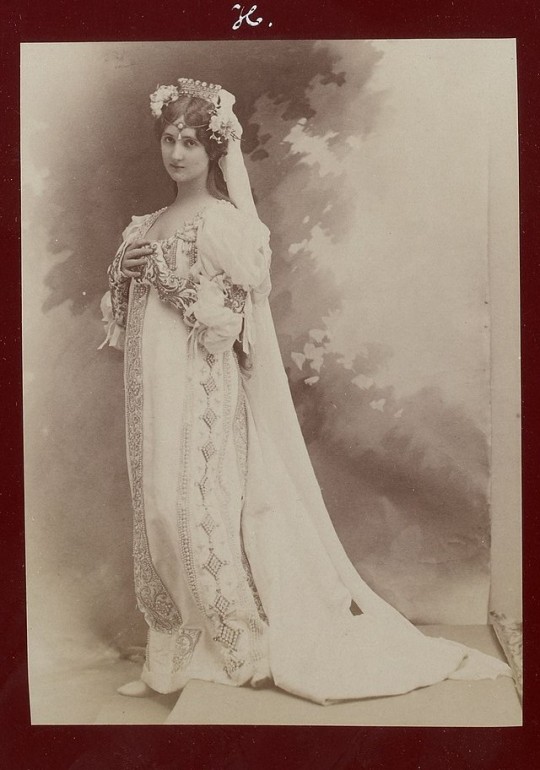



Catherine Mastio as Hero in play "Much ado about nothing" at Opera Comique, 1899; Photograph by Leopold Emile Reutlinger
#stage costume#mdptheatre#photography#france#19th c. france#19th century#opera#headdress#leopold emile Reutlinger
502 notes
·
View notes
Text

L'Art et la mode, no. 42, vol. 15, 20 octobre 1894, Paris. Créations inédites. Dessin de C. Billié. Bibliothèque nationale de France
Toilette de ville en drap mastic, brodé au plumetis sur un dessous de velours hanneton. Corsage de velours garni de bretelles formant choux à la taille. Manches larges, poignets drap brodé. Chapeau 1830, en feutre mastic, garni de velours hanneton.
City ensemble in mastic cloth, embroidered with plumetis on a chafer velvet underside. Velvet bodice trimmed with straps forming cabbages at the waist. Wide sleeves, embroidered cloth cuffs. 1830 hat, in mastic felt, trimmed with chafer velvet.
—
Robe de visites, en velours Parme, brodée de jais, garnie de vison et de velours aubergine. Manches toutes brodées. Chapeau en feutre noir, garni de plumes et de roses de velours aubergine.
Visiting dress, in Parma velvet, embroidered with jet, trimmed with mink and aubergine velvet. Fully embroidered sleeves. Black felt hat, trimmed with feathers and aubergine velvet roses.
—
Collet en fourrure, garni de velours gris mauve rebrodé formant longues pointes devant. Choux aux épaules. Capeline Louis XVI, garnie de plumes noires et de violettes.
Fur collar, trimmed with mauve-gray velvet embroidered into long points at the front. Shoulder puffs. Louis XVI wide-brimmed hat, trimmed with black and violet feathers.
—
Collet en velours noir et moire blanche brodée de jais. Bord de plumes noires, bretelles en velours noir. Chapeau "petit abbé", garni de plumes.
Collar in black velvet and white moire embroidered with jet. Edge of black feathers, straps in black velvet. "Petit abbé" hat, trimmed with feathers.
—
Manteau de voiture, en velours noir et hermine, rattaché aux épaules par des motifs de jais et cabochons; revers en soie vieux rose, avec jais en bas. Toque en plumes noires et velours vieux rose. — Manchon velours.
Car coat, in black velvet and ermine, attached at the shoulders with jet and cabochon motifs; old pink silk lapels, with jet at the bottom. Black feather and old pink velvet toque. — Velvet muff.
#L'Art et la mode#19th century#1890s#1894#on this day#October 20#periodical#fashion#fashion plate#description#bibliothèque nationale de france#dress#coat#cape#gigot#Modèles de chez#C. Billiè#collar
91 notes
·
View notes
Text
Hostile historians have stigmatized him as a usurper, while admitting that the suffrages of the nation placed him on the throne, they have denounced him a tyrant inexorable as Nero, while admitting that he won the adoring love of his subjects, he is called a bloodthirsty monster, delighting in war, yet it is confessed that he was, in almost every conflict, struggling in self-defense and imploring peace, it is said that his insatiable ambition led him to trample remorselessly upon the rights of other nations, while it is confessed that Europe was astonished by his moderation and generosity in every treaty which he made with his vanquished foes; he is described as a human butcher, reckless of suffering, who regarded his soldiers merely as food for powder, and yet, on the same page, we are told that he wept over the carnage of the battle-field, tenderly pressed the hand of the dying, and won from those soldiers who laid down their lives in his service a fervour of love which earth has never seen paralleled; it is recorded that France at last became weary of him and drove him from the throne, and in the next paragraph we are informed that, as soon as the bayonets of the Allies had disappeared from France, the whole nation rose to call him back from his exile, with unanimity so unprecedented, that without the shedding one drop of blood he traversed the whole of France, entered Paris, and reascended the throne, it is affirmed that a second time France, weary of his despotism, expelled him, and yet it is at the same time recorded that this same France demanded of his executioners his beloved remains, received them with national enthusiasm, consigned them to a tomb in the very bosom of its capital, and has reared over them such a mausoleum as honours the grave of no other mortal. Such is Napoleon as described by his enemies.
The Life of Napoleon Bonaparte, John S. C. Abbott
#John S. C. Abbott#Abbott#Napoleon#napoleon bonaparte#napoleonic era#napoleonic#first french empire#19th century#french empire#france#history#the life of Napoleon Bonaparte#quote#quotes#ref#reference#John Stevens Cabot Abbott#Maine#New Englander historian#french revolution#vintage book#vintage#History of Napoleon Bonaparte
26 notes
·
View notes
Text

TODAYS CHARACTER WHO HATES HAUSSMANIZATION IS: Sonic
1 note
·
View note
Note
"Betray him first, and the game’s reversed!"
@covrroucer || thank you!
Her eyes flickered from Armand's face to pick out that of her pimp's beyond the shadows of the night. Every now and then the moon rewarded her with colour, but it was never more than rouged cheeks of working women or the rare glimpse of expensive fabrics of more notable clients.
"I don't know what games you play, Monsieur, nor the circles you run in, but betrayal doesn't go down too well in these parts."
They played a game every single day— these women were all looking to out-do the other, willing to climb over each other to potentially escape whatever this existence was. Yet should one of their own rock the boat, cause ripples in the comfort of their pond, vultures became hounds.
"But you speak with an air of an experience, so please humour me... were you also successful?"
#covrroucer#c; armand chauvelin#v; undetermined#answered ask#thank you!#fantine... a woman in 19th century france...#she doesn't think betrayal would end too well for her tbh#especially when honesty never did looool
1 note
·
View note
Text

The "Rubens Vase," an Agate Hardstone Carving of c. A.D. 400,
Carved in high relief from a single piece of agate, this extraordinary vase was most likely created in an imperial workshop for a Byzantine emperor.
It made its way to France, probably carried off as treasure after the sack of Constantinople in 1204 during the Fourth Crusade, where it passed through the hands of some of the most renowned collectors of western Europe, including the Dukes of Anjou and King Charles V of France.
In 1619, the vase was purchased by the great Flemish painter Peter Paul Rubens (1577-1640). A drawing that he made of it is now in Saint Petersburg, State Hermitage Museum, inv. 5430.
The subsequent fate of the vase before the 19th century is obscure. The gold mount around its rim is struck with a French gold-standard mark used in 1809-1819 and with the guarantee stamp of the French departement of Ain.
A similar late Roman agate vessel, the "Waddesdon Vase" or "Cellini Vase," in now in the British Museum, London.
The Walters Art Museum, Baltimore, Maryland.
#art#history#design#style#archeology#sculpture#antiquity#collectors#vase#peter paul rubens#roman#agate#walters art museum#hardstone#hand carved#vessel#byzantine#imperial
316 notes
·
View notes
Text

Sukkoth. oil on canvas by Edouard Moyse, c. 1860. Edouard Moyse, who took his father's first name as his surname, was the first French painter to depict scenes of Jewish life. Alongside Edouard Brandon and Alphonse Levy, he was one of the most significant Jewish artists in France in the 19th century.
#jewish#judaism#jewblr#jumblr#art#art history#jewish art#jewish art history#oil on canvas#oil painting#painting#sukkot#edouard moyse
283 notes
·
View notes
Text

Allegory of Wealth
Artist: Simon Vouet (French, 1590–1649)
Date: c. 1640
Medium: Oil on canvas
Collection: Louvre Museum, Paris, France
Description
Allegory of Wealth is a circa 1640 painting by the French Baroque artist Simon Vouet. Allegory of Wealth is its traditional title, though Nicolas Milovanovic argues that it should instead be entitled Allegory of Contempt for Wealth and the Louvre (where it now hangs) entitles it Allegory of Faith and of Contempt for Wealth.
Probably painted for Louis XIII's château at Saint-Germain-en-Laye, it is first mentioned in the French royal collection inventories early in the 18th century as Victory crowned with laurels holding in her arms an infant with a sash and an infant holding bracelets and precious stones. Frédéric Villot entitled it La Richesse in the mid-19th century and this title was not contested until 2015.
#allegorical art#allegory of wealth#painting#oil on canvas#simon vouet#french painter#fine art#17th century painting#european art#putti#female figure#olive crown#wings#jewels#riches#book
32 notes
·
View notes
Text
Have been reading the Inferno alongside Les Mis, and am just so taken by the similarities between the two, the poem seems so important to Hugo's conception of his own project in Les Mis.
Hugo's poem 'After Reading Dante' starts: 'The poet, when he painted hell, was painting/His life', and its last stanza begins 'Yes, poet, that [hell] is life indeed', which seems pretty relevant. He's writing about 19th C France; Dante's writing about... literal hell; they're both documenting with excruciating detail the profound misery of an astonishingly large cast of characters. Hugo gestures at this pretty explicitly today, talking about Valjean in chains:
Certainly, and we do not wish to pretend otherwise, the observant physiologist would have seen irremediable misery there, would perhaps have felt sorry for this man made sick by the law, but he would not even have attempted a cure; he would have averted his gaze from the bottomless pit he had glimpsed in that soul, and, like Dante at the gates of hell, he would have erased from that existence the word that the finger of God nonetheless writes on the forehead of every man: Hope!
Both Hugo and Dante, unlike the physiologist here, refuse to avert their gazes from the “bottomless pit” of human misery. And although Dante indeed writes 'Abandon all hope ye who enter here' on the gates of hell, there is a final hope maintained by many of the damned Dante meets: having their story heard and told by Dante himself.
Fascinating to get as Hugo begins to tell the story of the misery of Valjean, whose imprisonment Hugo describes later as hell.
#shoutout scholarly consensus that hugo never read purgatorio or paradisio btw#and shoutout after reading dante#a banger of a sonata (lizst!!) if ever there was one#les mis letters#lm 1.2.7#les mis#dante#mine
23 notes
·
View notes
Text





























portrayals of bats in the 19th century:
Yashô (Japanese , 1782-1825) - Bat in Flight - ink on paper - early 1800s
Nicolas Huet the Younger (French, 1770–1830) - Bat - 1809
Joseph Severn (English, 1793–1879) - Ariel Riding on a Bat - oil on panel - 1820
Yamada Hōgyoku (Japanese, active c.1804-1844) - Bat and Moon - c.1830
Hiroshige (Japanese, 1797-1858) - Bats and Branch
Hōraku (Japanese, active early to mid-19th century) - Owl and Bat -netsuke (two views)
Hōraku (Japanese, active early to mid-19th century) - Bat on Roof Tile - netsuke
Greater Javelin Bat - from Grand Illustrated Encyclopedia of Animated Nature - 1856
Bat fitting - bronze - China - Qing dynasty (1644-1911)
F.W. Key - Bats - illustration from Links in the Chain; Or, Popular Chapters on the Curiosities of Animal Life by George Kearley - 1862
Bowl with bat - Japan - 1870
Isshō (Japanese) - A Bat Flying Near a Pine Tree - painting
Vincent Van Gogh (Dutch, 1853-1890) - De Vleermuiz (The Bat) - (portraying a taxidermied flying fox) - 1886
Design for a Japanese Window - Catalog from Belcher Mosaic Glass Co.; New York - 1886
Hyakunen Suzuki (Japanese, 1825–1891) - Bat and Willow Tree - fan painting
Bat - sulphide marble - late 19th century
Bat button - silver - Art Nouveau - France - late 19th century
Bat - Ojime bead - ivory - Japan - late 19th century
Peach-Shaped Vessel with Bat - porcelain - China - Qing dynasty
Tonkotsu (tobacco container) with lucky bats - Japan
bookcover for 'Stories and Interludes' by Barry Pain - 1892
Antonio de la Gandara (French, 1861-1917) - illustration for the book 'Les Chauves-Souris' (The Bats) by R. Montesquiou - 1895
Vase with Bats - earthenware ceramic - Art Nouveau - 1896
two illustrations of Bats from Cassell’s Natural History - 1896
Cover of 'Dracula' - 1st Edition - Bram Stoker - 1897
Rene Lalique (French, 1860-1945) - Batgirl pendant - gold with enameled wings & pearl - 1898
Rene Lalique (French, 1860-1945) - bat anklet - 1899
#art by others#other's artwork#sculpture#painting#print#ceramic#book cover#jewelry#container#marble#Rene Lalique#Antonio de la Gandara#ivory#silver#Hyakunen Suzuki#Yashô#Nicolas Huet#Joseph Severn#Hiroshige#Yamada Hōgyoku#netsuke#button#fan painting
44 notes
·
View notes
Text

Jacques-Louis David
Artists: Anonymous Artist, Georges Rouget (French, 1784-1869)
Date: c. 1813/1815
Medium: Oil on canvas
Collection: National Gallery of Art, Washington, DC, United States
Jacques-Louis David
Jacques-Louis David (30 August 1748 – 29 December 1825) was a French painter in the Neoclassical style, considered to be the preeminent painter of the era. In the 1780s, his cerebral brand of history painting marked a change in taste away from Rococo frivolity toward classical austerity, severity, and heightened feeling, which harmonized with the moral climate of the final years of the Ancien Régime.
David later became an active supporter of the French Revolution and friend of Maximilien Robespierre (1758–1794), and was effectively a dictator of the arts under the French Republic. Imprisoned after Robespierre's fall from power, he aligned himself with yet another political regime upon his release: that of Napoleon, the First Consul of France. At this time he developed his Empire style, notable for its use of warm Venetian colours. After Napoleon's fall from Imperial power and the Bourbon revival, David exiled himself to Brussels, then in the United Kingdom of the Netherlands, where he remained until his death. David had many pupils, making him the strongest influence in French art of the early 19th century, especially academic Salon painting.
#portrait#painting#oil on canvas#jacques louis david#french painter#georges rouget#french culture#man#seated#fine art#french history#costume#artist#paint brush#19th century painting
30 notes
·
View notes
Photo

Elisabeth-de-Riquet-de-Caraman-Chimay,Countess of Greffuhle, c. 1887 by Nadar
108 notes
·
View notes
Note
apologies if you've received an ask about this / have made a post about it before (when i tried to search it up on your blog i first accidentally pasted in the entirety of my speech, but the second time i got it right and the only thing that showed up was the ask you answered about why healthcare is the way it is), but i'm very interested in learning about military medicine, specifically about its role in, as you said in the aforementioned ask, the creation of the hospital/clinic system—do you have any specific readings that would be a good introduction to it?
yes, although i should've phrased that more precisely: the first anon was asking about the current US medical system, and my argument is that a lot of what's characteristically "fascist" (as they put it) about it has throughlines to medical knowledge transfer in the 19th-century Atlantic world, & particularly the influence of what is (sort of incorrectly) termed 'Paris medicine'. so, this is not a universal claim about hospitals (eg, there's lots of scholarship on hospital medicine in the Ottoman Empire, which functioned differently and had different relationships to military medicine, &c &c)
anyway i would recommend for some broad introductions to this process:
Medicalizing Blackness: Making Racial Difference in the Atlantic World, 1780-1840, by Rana Hogarth (2017)
The Citizen-Patient in Revolutionary and Imperial Paris, by Dora Wiener (2002)
Maladies of Empire: How Colonialism, Slavery, and War Transformed Medicine, by Jim Downs (2021)
and, jumping a bit to the late 19th century and the origins of 'modern medicine' generally:
The Emergence of Tropical Medicine in France, by Michael Osborne (2014)
Imperial Bodies in London: Empire, Mobility, and the Making of British Medicine, 1880–1914, by Kristin Hussey (2021)
Pasteur's Empire: Bacteriology and Politics in France, Its Colonies, and the World, by Aro Velmet (2020)
Curing the Colonizers: Hydrotherapy, Climatology, and French Colonial Spas, by Eric T. Jennings (2006)
71 notes
·
View notes
Text

Empire dress with short balloon sleeves
c. 1800-1810, Napoleonic era
Musée des Tissus, Lyon, France
#dress#empire#empire style#paisley#baloon sleeves#19th century#early 19th century#napoleonic era#first french empire#napoleonic#french empire#napoleon#france#peach#C. Jolivet et à Joseph-Benoît Richard#Lyon#French#French fashion#fashion history#history of fashion#historical fashion#1800s#1800s fashion#empire dress#regency#regency fashion#regency era#fashion#gown#pretty
39 notes
·
View notes
Text
The art of Perrault (1)
I found this fascinating article on an art-and-museum website talking about the few times Charles Perrault's fairytales entered the world of art. It's entirely in French, but for those non-French speakers I thought of sharing some elements and points made by the article.
First and foremost, their talk of the Gustave Doré illustrations, THE most famous illustrations of Perrault's fairytales to this day.

A few contextual reminders. We are in the 19th century, the time of nationalism, where each country focused onto itself, explaining the boom of interest for national folktales and fairytales. The literary Romanticism had also started to enter the world of the art - in the British world it was through the Victorian "fairy painting" wave of the 1850s and 1860s. And in France, right as the business of illustrated books and precious engravings is soaring, we got the Gustave Doré illustrations for Perrault.

The book they come from is the Pierre-Jules Hetzel Contes de Perrault edition of 1861 (illustrations by Gustave Doré, preface by P.-J. Stahl). It contains the eight prose tales of Perrault, from his Histoires ou Contes du temps passé (Sleeping Beauty, Little Red Riding Hood, Bluebeard, Puss in Boots, Cinderella, Little Thumbling, Toads and Diamonds, Riquet with the tuft), plus a prose version of Donkey Skin. The book contains 40 illustrations, all based on models and drawings of Doré, though done by several engravers that were selected by both Hetzel and Doré: François Pannemaker, Héliodore and Anthelme Pisan. In 1861 the engravings themselves were shown, on their own, at the art Salon de peinture et sculpture (the huge yearly artistic event of 19th century France) - they were destined for collections, be them the personal collections of Doré and his engravers, or those of wealthy collectors.

The order of the fairytales was changed in this edition, which decided to go: Little Red Riding Hood, Little Thumbling, Sleeping Beauty, Cinderella, Puss in Boots, Riquet with the tuft, Donkey Skin, Diamonds and Toads, and Bluebeard at the end.

The Bibliothèque Nationale of France and the Musée d'art moderne et contemporain of Strasbourg have both preserved precious photographies which were taken (by Nadar and Michelez) of the original wood-drawings Doré made for these illustrations. Doré had them exposed at the Louis Martinet galerie, and these photos are VERY precious because they are the only trace we have of Doré's original plans for these pictures - as well as the only way we can know of what changes and modifications the engravers brought to them.

Doré's illustrations reveal many things. First and foremost, how fairytales clearly were not just for children at the time. While he tries to stay true to the letter of Perrault's stories, Doré still uses a Romantisme noir style (dark Romanticism), offering dramatic, phantasmagorical, almost oppressive visions. The complex engravings play on the lights and the shadows, on the size of the characters and those of the landscape ; they also make heavy use of the monstrous and the uncanny. In the Little Thumbling illustrations, there is an effort to convey the loneliness and anguish of the characters - the forest is endless, dark and scary, swallowing the children... The compositions are however still very detailed, with a lot of accumulations, because they are to be beautiful and aesthetically pleasing. For example, the picture of Bluebeard's wife receiving the keys shows a lot of precious cloth and a varied jewelry - and this overbearing of the decorum, mixed with the unusual appearance of Bluebeard (especially his gaze) all conveys the tragedy that is unfolding here.

By opposition to these scenes of cruelty and tragedy, Doré makes several more "peaceful" illustrations. Sleeping Beauty and Cinderella are still filled with mystery and disturbingness, but they are rather dominated by the sweetness of the two young women. Doré doesn't limit himself to strong and isolated characters, on the contrary he creates an entire "decorative universe" just to have his characters fit into a narrative. The overabundance of tiny details causes an almost unconscious reverie, making the audience almost "re-discover" Perrault texts anew.

The illustrations of Doré caused the massive success of the Hetzel edition, and very quickly these pictures became part of popular culture, influencing the way Perrault's fairytales were perceived up to this day.

#gustave doré#perrault fairytales#fairytale illustrations#fairytale art#french fairytales#charles perrault#bluebeard#little thumbling
30 notes
·
View notes
Text
A. Z. Fell & Co. bookshop and its statues, part 2
Welcome to the second part of my insane deep dive into Aziraphale’s world of slightly outdated decor, golden-colored trinkets, and their ostentatiously Greek (especially for a representative of an originally Judeo-Christian mythology) symbolism. As a short recap, the last installment covered six pieces in the northern and central sections of the bookshop plus a plot-important medal previously displayed on one of them, but currently left with the other bibelots on the bookseller’s desk. We’ll start right there, where we previously left off.
While a lot of the bookshop action plays out in the circle between the formerly discussed statues, its office part is especially close to Aziraphale himself. As the titular Guardian of the Eastern Gate, the angel consciously spends most of his time in this small space in the Eastern part of the bookshop, confined to his desk or reading stand. This means that the decorations of this area have more personal significance and are most probably used as daily reminders for him to keep his thoughts and priorities on track as much as provide pleasant distraction from the weary eyes.
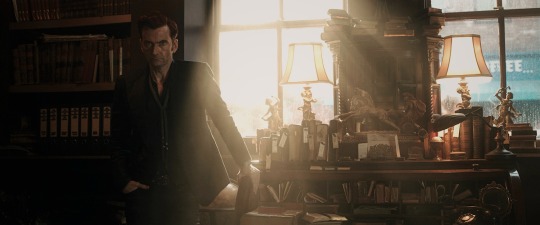
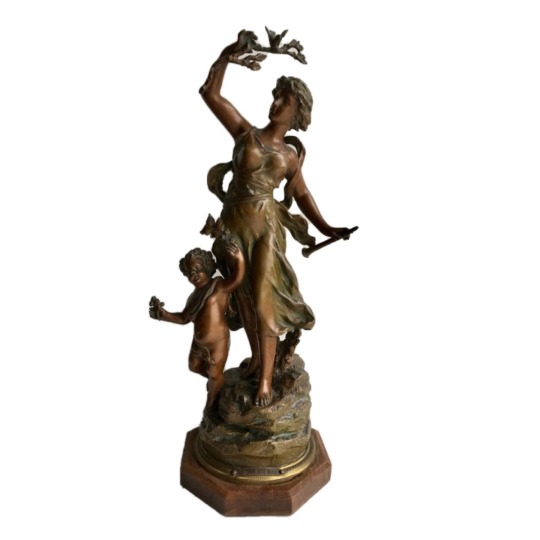
The two windowsill figures of the Art Deco dancers from S1 were replaced by a somewhat similar set of twin statues by Ernest Rancoulet called Retour des Bois (Return from the Woods). Depicting a young woman accompanied by a putto, Aphrodite and Eros, frolicking in a dance through the woods and meadows. This bucolic fantasy with Aphrodite makes some sense when we consider how Aziraphale’s personal love story started (and will presumably end) in a garden, but let’s deep deeper into its protagonists. Or protagonist, actually, because what else can be told about Love itself?
Eros as the god of Desire is usually presented in art as a handsome young man, though in some appearances he is a boy full of mischief, ever in the company of his mother. It is usually under the guidance of Aphrodite when he employs his signature bow and arrows to make mortals and immortals alike to fall in love. His role in myths is mostly complementary, as a catalyst for other mythological figures and their stories, with the notable exception being the myth of Eros and Psyche, the story of how he met and fell in love with his wife.
In short, they are the original star-crossed lovers from entirely separate worlds who meet and fall in love by divine happenstance, only to be separated by Psyche’s family. Convinced by her sisters that her husband is, in fact, a vile winged serpent, Psyche breaks his one rule and the attempt to kill the monster leads her to falling in passionate love with him. Eros flees and Psyche wanders the Earth searching for him and succumbing to a series of impossible tasks reminding of those from the Scarborough Fair ballad or the more modern fairytale about Cinderella. She ultimately fails, but is saved by the healed Eros, granted immortality and the status of his equal, after which they can properly marry with a huge wedding banquet, a real feast of the gods.
In the Christian Middle Ages, the union of Eros and Psyche started to symbolize the temptation and fall of the human soul, driven by the sexual curiosity and lust from the Love’s domain, mirroring the original sin and the expulsion from Eden.
Oh, and their Latin names? Cupid and Anima. C+A.
We’ll get back to them in a minute.

According to unnecessary but extensive research, the two mid-century table lamps standing over the desk were most probably produced in France after another unspecified 19th century sculptor like the example above, although this particular putti design can be also found in the so called Hollywood regency style of the same time period. The putto is holding onto a cornucopia, a classical antiquity symbol of plenty, which then continues to the bulb section.
The cornucopia is an easily recognizable symbol of abundance, fertility and, to lesser extant, peace and good fortune. Since the horn is phallic-shaped, but hollow at the same time, it combines intimate imagery of both male and female character at the same time, which further ties into notions of fertility. In its role as a fertility symbol, the cornucopia is also usually associated with Demeter, whose small statue is also standing on the bookshop’s counter. Which seems like a recurring theme.

I saw multiple theories about Aziraphale’s centerpiece, but somehow the truth proved to be much less significant than previously thought. This roman soldier, possibly a centurion, driving his two horses in a highly decorated chariot is made from a marble powder resin composite and takes the most visible place in the Eastern part of the bookshop even though it’s seemingly one of the newest additions to Aziraphale’s collection — its author, Lorenzo Toni, was born in 1938 and became a sculpture master by the 1970s.
At first glance, the parallel to the Marly Horses seems obvious and we could leave it basically at what was written recently on Crowley and Aziraphale’s dynamics. But here is where instead of commenting on the antique sculpture that seems to be the inspiration behind this piece or the many intricacies of Roman chariot racing I’ll do something completely unhinged — i.e., play my Greek philosophy card.
In the dialogue "Phaedrus ”, Plato presents the allegory of the chariot to explain the tripartite nature of the human soul or — you guessed it — psyche. The charioteer is the man’s Reason, the rational part that loves truth and knowledge, which should rule over the other parts of the soul through the use of logic. One of the horses, the white one, is man’s Spirit, a motivated part which seeks glory, honor, recognition and victory. The second horse, the black one, represents man’s Appetite — an ever so hungry part which desires food, drink, material wealth and physical intimacy.
And the fun part? This triad is established to analyze the madness of love. In a classical Greek context, that is not between a man and a woman, but erastes and eromenos:
The charioteer is filled with warmth and desire as he gazes into the eyes of the one he loves. The good horse is controlled by its sense of shame, but the bad horse, overcome with desire, does everything it can to go up to the boy and suggest to it the pleasures of sex. The bad horse eventually wears out its charioteer and partner, and drags them towards the boy; yet when the charioteer looks into the boy's face, his memory is carried back to the sight of the forms of beauty and self-control he had with the gods, and pulls back violently on the reins. As this occurs over and over, the bad horse eventually becomes obedient and finally dies of fright when seeing the boy's face, allowing the lover's soul to follow the boy in reverence and awe. The lover now pursues the boy. As he gets closer to his quarry, and the love is reciprocated, the opportunity for sexual contact again presents itself. If the lover and beloved surpass this desire they have won the "true Olympic Contests"; it is the perfect combination of human self-control and divine madness, and after death, their souls return to heaven.
And such a perfect combination of the motifs already introduced to us by the two Eros statues and the Head of the Victorious Athlete.

Aziraphale might be a titular Companion to Owls (or, to be precise, the companion to one particular Nite Owl), but he had also made sure to have at least one owl keeping him company. And of course, the owl of Athena (who was interestingly both a bird and a snake goddess) is an absolutely conclusion here as the universal symbol of wisdom and knowledge in the Western culture, but it can’t be that easy, right?
In the Bible, you'll find that owls often symbolize something unclean and forbidden, as well as desolation, loneliness, and destruction. This symbolic significance is pointed out in Leviticus 11:16-17 and Deuteronomy 14:11-17 where owls are mentioned among the birds not to be eaten. Owls were considered unclean most likely because they are predatory creatures who eat raw flesh with the blood still in it, and that was an even bigger food safety concern for the biblical nomads than to us today.
Owls are also among the wild predators that have long dwelled in the desert lands and abandoned ruins of Egypt and the Holy Land. Both Isaiah and Zephaniah speak of owls nesting in ruined wastelands to paint symbolic images of barrenness, emptiness, and utter desolation. In Psalm 102:3–6, the owl symbolizes the loneliness of the psalmist’s tortured heart:
For my days vanish like smoke; my bones burn like glowing embers. My heart is blighted and withered like grass; I forget to eat my food. In my distress I groan aloud and am reduced to skin and bones. I am like a desert owl, like an owl among the ruins. I lie awake; I have become like a bird alone on a roof. All day long my enemies taunt me; those who rail against me use my name as a curse. For I eat ashes as my food and mingle my drink with tears because of your great wrath, for you have taken me up and thrown me aside. My days are like the evening shadow; I wither away like grass. But you, Lord, sit enthroned forever; your renown endures through all generations.
It’s a devastating, but still beautiful piece that deals with the feeling of utter rejection, the ultimate bad breakup of the relationship between a human and their God. And this… simply didn’t happen between God and Aziraphale, not even during his Job job. The angel had always considered Her love and ineffability as a given, even when the whole Heavenly Host was against him during the Non-Apocalypse. His allegiance stayed with God, not necessarily Her angels. Which brings us yet again to the motion of Crowley as the owl.
The angel and the demon are the companions to each other's loneliness, but Aziraphale’s needs seem significantly bigger than their Arrangement that he even considered a wooden substitute protectively hovering over him 24/7. He seems to be the one who is the loneliest and most rejected.
Oh, and if you think that putting a small bronze statue of a putto with a bronze putto-shaped candleholder right behind it (visible on the filing cabinet in the bottom right corner) is already a stretch, let me show you what’s on the other side of that wall.


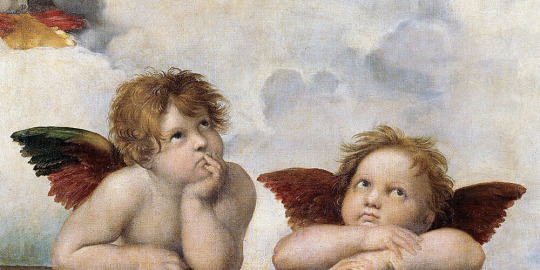
Just like before the bookshop fire, the famous sink in the small backroom is adorned with a perfectly kitschy white plaster sculpture of The Two Cherubs, a small part of a larger painting by Raphael (the painter, not the Archangel) titled Sistine Madonna. In the painting the Madonna, holding Christ Child and flanked by Saint Sixtus and Saint Barbara, stands on clouds before dozens of obscured putti, while two distinctive winged putti rest on their elbows beneath her. with bombastic side eyes and clearly unspoken, but very controversial thoughts about the whole scene and their role in it.
With an attitude like that, there’s no wonder that the putti have inspired some legends. According to one, the original cherubs were children of one of his models they would come in to watch. Struck by their posture, he added them to the painting exactly as he saw them. Another story says that Raphael was inspired by two street urchins looking wistfully into the window of a baker's shop.
The Germans implicitly tied this painting into a legend of their own, "Raphael's Dream." Arising in the last decades of the 18th century, the legend — which made its way into a number of stories and even a play — presents Raphael as receiving a heavenly vision that enabled him to present his divine Madonna. It is claimed the painting has stirred many viewers, and that at the sight of the canvas some were transfixed to a state of religious ecstasy akin to Stendhal Syndrome (including one of Freud's patients).
Their big, seemingly cherubic companion doesn’t seem to have a specific provenance, but what’s left of his limbs might suggest that it could be an infant Jesus as well as another putto. But honestly who knows at this point.
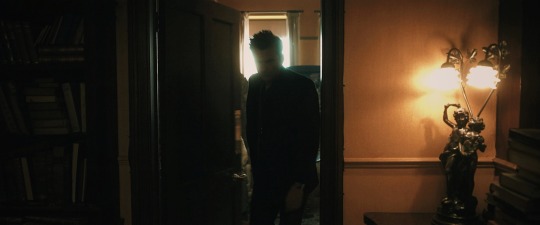

On the other side of the same room, right at the door leading to the big backroom, there are two lamps with Auguste Moreau’s Young Lovers, a bronze sculpture depicting a courting couple on the verge of a physical embrace, holding garlands of roses and hiding under some old vines. Which aligns perfectly with the beloved romcom trope of a rain shelter leading to sudden love realizations, as well as Crowley choosing this part of the bookshop to have a word with his angel in private and then offering his advice on anything related to human love. No wonder that the angel looked at him like that.
This statue carries with it more than one allegorical interpretation, intentional or not. Arguably the most obvious one is the myth of Eros and Psyche, one we already covered in this post. But similarly to his earlier sculpture, Eros also serves here as an allegory for nature and the return to the natural state itself. Like Adam in Eden, he's unclothed and symbolically crowned as a ruler of his domain. Psyche, enamored with his confidence, is about to take her own leap of faith as her fabric restraints fall away. One could say that she's tempted to follow him into nature, deep into the garden of love.
And with that exact thought I will leave you today, dear reader. Through this analysis we learnt many things, among them two significant facts about Aziraphale: firstly, he’s an utter and incorrigible romantic, and secondly, a hoarder. Forget Crowley’s souvenirs — the amount of this angel’s statues is something else. And it isn’t even his hyperfixation!
#yuri is doing her thing#good omens#good omens 2#go2#aziraphale#crowley#c+a#crowley needs a hug#aziraphale is a hoarder#ineffable idiots#ineffable husbands#ineffable divorcés#a. z. fell#a. z. fell & co.#aziraphale’s bookshop#bookshop statues#statues update#set design#the good omens crew is unhinged#raphael#greek mythology#bible fanfiction
146 notes
·
View notes